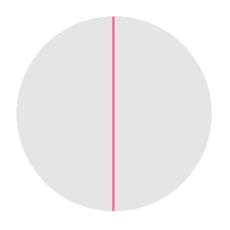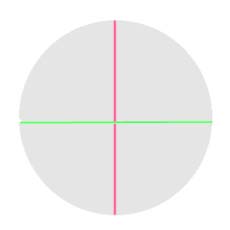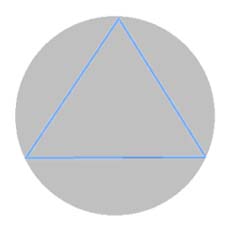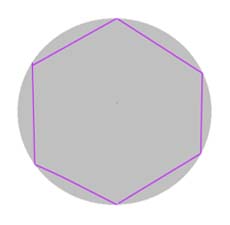Cosmic Events and Other Astrological Stuff
Aspects
by Jenni Muscat
 I've been asked at various times during my astrological journey and studies in regards to this rather fascinating and complex subject. Knowing and understanding how each of the planets make an aspect to each other is one of the most basic fundamental concepts an astrologer must be able to utilise when delineating a chart. And yet, it can be a rather daunting task to undertake, even for the most seasoned astrologer. When a layperson asks "What's an aspect?" the question can throw you. You want to explain it in as simple a term as possible, but you inadvertently fall into a jargon that you're used to applying when you're around other astrologers. In other words, without the time to convey it properly in a language that the average person can understand, you would only confuse that person more than to begin with!
I've been asked at various times during my astrological journey and studies in regards to this rather fascinating and complex subject. Knowing and understanding how each of the planets make an aspect to each other is one of the most basic fundamental concepts an astrologer must be able to utilise when delineating a chart. And yet, it can be a rather daunting task to undertake, even for the most seasoned astrologer. When a layperson asks "What's an aspect?" the question can throw you. You want to explain it in as simple a term as possible, but you inadvertently fall into a jargon that you're used to applying when you're around other astrologers. In other words, without the time to convey it properly in a language that the average person can understand, you would only confuse that person more than to begin with!
I don't want to throw the reader off with this opening remark, however. Because when you think about it, it's a simple process of applying some basic mathematical equations. It really is, and this is coming from someone whose mathematical skills never went beyond the necessary basics when I learned at school - more than 30 years ago now.
 Let's begin with the basics then. The horoscope consists of a circle that is always 360 degrees round. Two or more planets in close proximity to each other that won't form any of the other aspects (which are explained later) will form what's called a conjunction.
Let's begin with the basics then. The horoscope consists of a circle that is always 360 degrees round. Two or more planets in close proximity to each other that won't form any of the other aspects (which are explained later) will form what's called a conjunction.
As an example we have the Sun and Moon forming a conjunction every month that heralds the start of the new moon phase. As yet, there is no other aspect to be formed as it is in a tight formation, keeping the circle whole. This formation doesn't offer any great degree of separation so the two planets involved could be seen as living in each other's pockets. They are conjoined, like identical twins. While there is a hint of individuality from each planet involved, they are always interconnected to the point that there is a mirror effect on each other.
The next of the major aspects that is significant is the opposition.
 As you can see, we have divided the circle into an exact half of 180 degrees and formed an opposition. One planet will be directly across from the other to form this aspect. An opposition is considered a hard aspect, because of its position. We have a line that partitions one half of the circle from the other.
As you can see, we have divided the circle into an exact half of 180 degrees and formed an opposition. One planet will be directly across from the other to form this aspect. An opposition is considered a hard aspect, because of its position. We have a line that partitions one half of the circle from the other.
When a person has one or more oppositions in their chart, it will present a conflict between the two planets involved. Let's take Saturn and Uranus as an example of extreme differences. Saturn is about structure and form, rules and authority, routine and boundaries. Uranus is creative genius, insurgency, challenging the status quo, change and reform, new ideas and concepts. We have two powerful planets that would otherwise be set on an eternal collision course. However, they are opposite each other for a reason and here lies the perfection of timing during birth. There is nothing accidental about planetary alignments and this is a perfect example of how two such planets are able to compliment each other and work together to produce a valuable partnership.
The person in question can use this opposition in two ways. Depending on the level of spiritual development, he will always be in a quandary, one day bowing to authority and turn completely around the next - without having any idea as to why. The other way he can go is, when armed with this type of knowledge, he can learn to understand these differences about himself and utilise them in a way that is more favourable. Oppositions can't change. Challenges will still arise and they always will. It's how they are perceived by an individual and worked with that count.
The next challenging aspect (and in my opinion the most difficult) is the square.
 The square is now divided into quarters of 90 degrees each. The diagram with planetary alignments on all four angles will form a grand cross. Such an angle provides conflict on another level that only a square can provide. A person with one or more of these will always feel like that they are at a constant odds with their moods and ideals.
The square is now divided into quarters of 90 degrees each. The diagram with planetary alignments on all four angles will form a grand cross. Such an angle provides conflict on another level that only a square can provide. A person with one or more of these will always feel like that they are at a constant odds with their moods and ideals.
A good example would be a person who has a Moon squaring Mercury. The Moon is about deep emotions, nurturing and receiving, insight and intuition while Mercury is about swift movement, communication, early learning, writing and studying. This type of square makes it difficult somewhat for a person to communicate his feelings at times, especially when there is a great need to do so. This person can get caught up in the dramas of others, especially by malicious gossip. Problems with communicating in a more appropriate way can create huge tension, with the individual becoming stressed, depressed and even ill. Knowing these triggers and when they are most likely to occur (there is a regular occurrence to such patterns which I will explain later) is a great aid to making those necessary adjustments to your well-being and assist you in riding out the more tempestuous, emotional storms. I'm willing to bet that the great novelists of our era have had to struggle in similar ways with their emotions and they found their creative outlet in writing - this is but one example and there would be other outlets to choose from.
The next major aspect we have is one of the more favourable, and what's called a trine. This diagram has the aspect evenly divided into 120 degree thirds.
 Please pardon my off-kilter drawing, but you get the basic idea. Two planetary alignments will make a trine, and the diagram I have drawn is that of a grand trine. To have one or more trines (not necessarily to form a grand) is to have planetary aspects that make for a more harmonious outlook, a serene and carefree attitude.
Please pardon my off-kilter drawing, but you get the basic idea. Two planetary alignments will make a trine, and the diagram I have drawn is that of a grand trine. To have one or more trines (not necessarily to form a grand) is to have planetary aspects that make for a more harmonious outlook, a serene and carefree attitude.
Such attitudes, sadly, need to be tested at times and the person who has many trines in his chart may have difficulty in coping when the harmonious periods become fraught with difficulty. There is a lack of understanding, a lack of empathy, and if tragedy strikes in some way or other, he could crumble under the pressure. He may have yet to experience such circumstances and as a result, he's all at sea and needing a lifeboat - to quote a metaphor.
A good example on how to work with a trine is when Mercury aspects Uranus in this way. He would be smart, maybe a genius. He would certainly have the technological smarts and put his work to great use. He would be interested in stimulating his brain and may be drawn to the more precise calculations of esoterics, such as astrology, numerology and astronomy. Such restless energy could eventually cause health problems if care isn't taken in pursuing other more earthly forms of leisure to keep him grounded and steady.
 The final major aspect of note would be a sextile. The planets are aligned 60 degrees apart and if you have 6 or more planets aspecting around the circle, it forms a grand sextile. A person who has a grand sextile in their chart is one rare person indeed and we need not concern ourselves with this aspect. For the rest of us mere mortals who would have only one or two in our chart, a sextile is also considered a favourable aspect but one which needs to be worked on and finely tuned.
The final major aspect of note would be a sextile. The planets are aligned 60 degrees apart and if you have 6 or more planets aspecting around the circle, it forms a grand sextile. A person who has a grand sextile in their chart is one rare person indeed and we need not concern ourselves with this aspect. For the rest of us mere mortals who would have only one or two in our chart, a sextile is also considered a favourable aspect but one which needs to be worked on and finely tuned.
An example of a sextile is Moon aspecting Mars. These individuals are normally healthy and robust, but they mustn't take their health and well-being for granted, or lean towards the reckless. This energy is childlike; illness and accidents could occur. From an emotional standpoint, this individual is very protective, steadfast and loyal. If he has children who feel frightened or threatened by another, he will go all out to stand up for them - even if he is seen to be overly protective at times.
Applying and Separating
This term has been bandied about quite regularly and it signifies in a horoscope - or natal chart - how the fastest planet aspects the slowest one. When the word applying is used, it's when the fastest moving planet is coming to within reach of the slowest moving one. When a planet has an applying aspect the intensity of it is more noted than when separated, but they both count at that fixed moment in time. One example would be of the Moon in its final balsamic phase approaching the Sun to within 10 degrees of forming a conjunction. Separation is when the same Moon has passed over the Sun and moved away but is still within 10 degrees of its conjunction phase.
The next applying phase the Moon would make is when it aspects the sun to form a square. When it has moved to 80 degrees before it makes its first quarter, it counts as an applying square before the exact point of impact, at 90 degrees. As the Moon moves away and sits within 100 degrees it is now a separating quarter.
The next major phase of the Moon is when it opposes the Sun and waxes to full, after 170 degrees but before it reaches 180 of exact. The Moon is on its waning phase after opposition but is now separating as full before reaching 190 degrees.
We then come to the last quarter when the Moon is in its separating aspect before reaching to exactness of 270 degrees - from 260 onwards. Once the 270 degree mark has passed it is back in the applying stage before hitting 280, before coming around to the new phase again. It can be seen that on either side of full that the Moon is both applying and/or separating but I wanted to keep my explanation as simple as possible to avoid any further confusion. I hope I haven't, by the way! It is also for this precise reason that I deliberately left out the other aspects as they don't apply to the major phases of the Moon and Sun, but would be valid to a natal chart.
How many degrees?
Each astrologer will apply his own rule of thumb in this instance, so therefore I speak for myself here. Since the Sun and Moon are both luminaries, 10 degrees on either side is perfectly acceptable for the conjunction, square and opposition. For the trine and sextile, eight and six degrees respectively would be sufficient. For the remaining planets, a good starting point would be eight degrees for the conjunction, square, opposition and trine, plus six degrees for the sextile. I would like to add that if it's the outer planets only that aspect each other, the degrees would need to be closer because they are slower to move and more distant in orbit.
Transits
The only exception to this rule of applying and separating is when the planets are in transit and you would choose a time frame when you would put a current chart over the horoscope. If, for example, you were to plan a trip six months from now and transiting Jupiter forms a separating square to natal Mars before reaching exact, you might want to take care with travel arrangements or wait until a later date if that's possible. In transit, the slower moving planets from Jupiter to Pluto are the ones to take the most note of, because of their direct and retrograde (appearing to move backward) motions covering a period of six months to two years, depending on the planet in question.
Regularity
This would tie in nicely with the above-mentioned transits and you would need to look at the zodiac sign the planets involved are in. If you had a Moon in Aquarius squaring Mercury in Scorpio and you had the transiting planet of Pluto forming a conjunction with Mercury, there would have been a great period of transformation for this person back in the decades of the eighties and nineties, which may have included a period of family upheavals, explosive arguments and a walking away from which was held emotionally dear. It would've been played out on a more communicative level because of its main aspect with Mercury. It would be safe to assume that he would only live to see that kind of aspect once in his lifetime as Pluto is the slowest of all the planets to orbit - and mercifully so!
Well, another month has come and gone since the last article, and you can bet the next month will be just as swift.
Until then, fare thee well.
All the diagrams drawn for this article have come from myself, using paint.net
Jenni lives south of Sydney with her three children and menagerie of pets. Her passion for Astrology has been utilised at great length for the last ten years. Along with self-learning, she has studied at the Sirius School of Astrology under the guidance of Ed Tamplin and Sherrynne Dalby. Jenni's other interests include Reiki, Feng Shui & intuitive alignment of the land and home, Heathenism, Shamanism, Crystals, Metaphysical Healing, Paranormal investigations (conducted through the SOuL Searchers team of Spheres Of Light) Tarot and Angel readings, along with gardening, walking, family & friends. Jenni has various creative endeavours including making candles, soaps and runes for sale, along with selling crystals and other trinkets.
Jenni can be contacted for consultations and merchandise on...
Mobile: 0438 741 964
Email: ladybryn@y7mail.com
(See links above for paranormal investigations)
